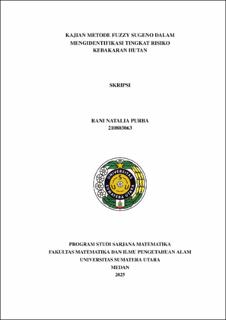Kajian Metode Fuzzy Sugeno dalam Mengidentifikasi Tingkat Risiko Kebakaran Hutan
A Study of The Sugeno Fuzzy Method for Identifying Forest Fire Risk Levels

Date
2025Author
Purba, Rani Natalia
Advisor(s)
Nababan, Esther Sorta Mauli
Gio, Prana Ugiana
Metadata
Show full item recordAbstract
In the implementation of fuzzy logic, the Sugeno fuzzy method faces several challenges,
such as issues in determining the fuzzy rule base and the occurrence of undefined outputs
(defuzzification) with values of 0/0. This study examines the application of the Sugeno
fuzzy method in identifying the level of forest fire risk by considering various variables,
such as temperature, humidity, and wind speed. The model is developed using fuzzy
rules constructed based on the relationships among the variables. The test results show
that after modifying the membership function boundaries to decimal values approaching
the original lower bounds, the Zero-Order Sugeno fuzzy method is capable of producing
an average forest fire risk level of 68.83 (high category) in Tanjung Puting National
Park. In addition, the application of the First-Order Sugeno fuzzy method produces a
multiple linear regression model that can be applied within the rule base, resulting in
an average forest fire risk level of 68.89 (high category) in the same location. During
the evaluation phase, the First-Order Sugeno model achieved a lower RMSE value
(15.47) compared to the Zero-Order model (16.03), indicating that it is more suitable for
handling extreme conditions such as dangerous spikes in risk. Therefore, this approach
has the potential to serve as an effective early warning system for forest fire mitigation,
supporting decision-making processes.
Collections
- Undergraduate Theses [1490]
